Frequency response graphs for headphones Bluedio and other brands: understand, expose, choose
From the very first of my material about excellent budget wireless headphones from China, Bluedio in the comments is asked to provide amplitude-frequency response graphics for each “ear” model (for simplicity I will continue to use the AFC abbreviation). I did not do this, not because I'm lazy. It’s just that these charts are not as straightforward as it may seem at first glance. However, I vowed to the venerable public to make material with a comparison of the frequency response, and the word must be kept. And yes, at your request this time - without funny pictures.
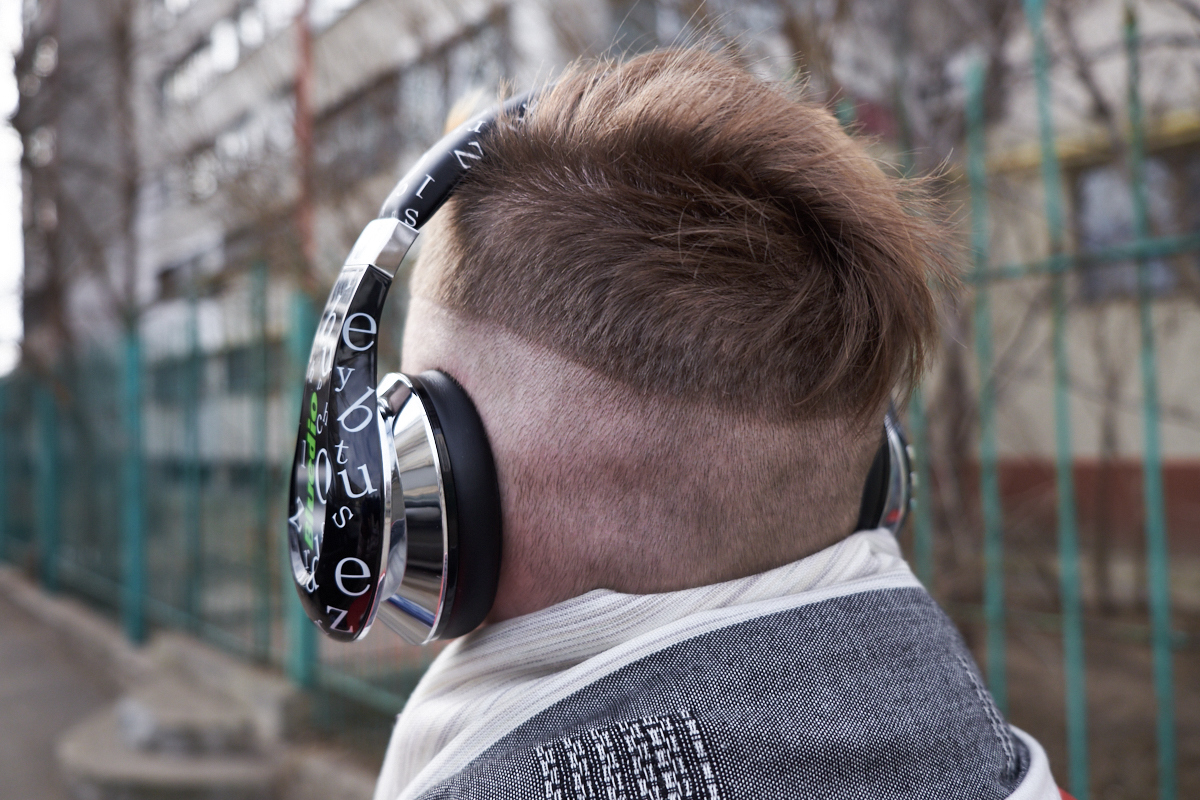
Let's first recall very quickly what this graph shows. The frequency response graph shows the level of sound pressure (loudness) over the entire frequency spectrum. It usually looks something like this:
')

At first glance, this is strange: what kind of curves, if we want all the frequencies to play the same? Come on straight line! But here biology interferes, namely the structure of our ear canal. The sounds in the ear are distorted, and so that we perceive music harmoniously, some frequencies must be played louder, some are quieter. Again, the headphone form factor has an effect: if they fit to the ear from the outside, some frequencies are heard better than others. If they are inserted into the ear canal, other frequencies come to the fore. To compensate for this, audio engineers have to twist the sound of the headphones, bending this very frequency response line. Therefore, a small failure in the frequency response at high frequencies is considered completely normal - this compensates for the features of the sound in the human ear.
Another nuance is that we all have different ears. And we hear the sounds in different ways. So the same headphones in the ears of two different people may sound oh-so-very different. So buy headphones for frequency response without first listening, I strongly advise you not to.
Personal preferences of users also play a role: not everyone needs “accurate” music playback. Someone likes to have more bass, and someone, on the contrary, can not tolerate low frequencies. Here the manufacturer and adapts as it can, experimenting with the frequency response.
And if you still have few nuances, here's another one: the older we get, the worse we hear the upper frequency spectrum. And if the child perfectly hears the range of 20 Hz - 20 kHz, then the adult does not hear anything above 17 kHz, unless he has specially trained his ear. So on the graph, ultra-high frequencies can not be given much attention.
In general, the rule for reading such graphs is one: good headphones differ from bad ones by the absence of sharp drops in the graph. If the lines are smooth, without narrow peaks and dips, the sound will be harmonious and pleasant. You will not necessarily like it personally (tastes!), But, in any case, headphones with a smooth frequency response graph are of high quality.
It seems that everything is very simple: look at the chart and determine. Here the basses are turned up, here the middle is failed, and here in general the devil knows what. But no matter how. The main question is who made the graphics, on what equipment and how it measured.
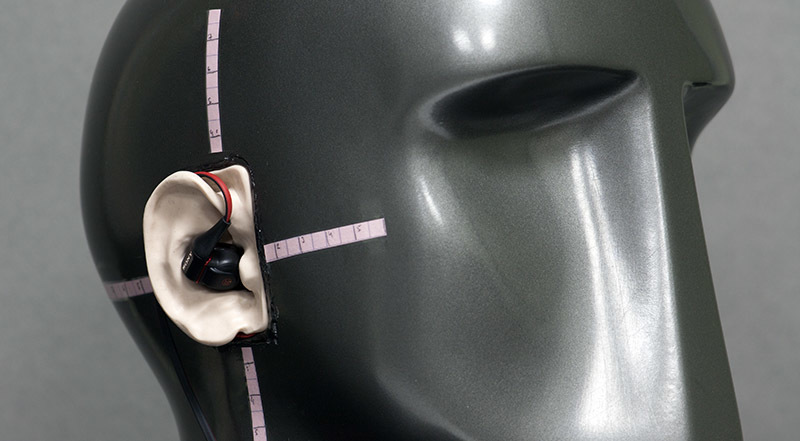
In an amicable way, the frequency response needs to be measured with a super-sensitive microphone set in an exact imitation of the human ear. This is what all the headphone manufacturers do (and some, like Bluedio, even have the courage to publish these graphics). More information about the stands and the inevitable errors even in laboratory conditions can be found here, at "Giktayms", in the material that breaks the covers . But something else is important for us: most manufacturers do not post AFC graphics at all. Whether they have nothing to be proud of, or arrogant vendors believe that such graphics are not for average minds - in any case, we were left without important characteristics. And all that remains for us is the frequency response graphs from the reviews of journalists. And there the spread is even stronger, because not every edition can provide good studio conditions for measurements.
Not to be unfounded, let's take a specific model of headphones and see the graphics. The Beats Solo 2 headphones, already familiar to you, received the following frequency response graph from the resource Ferra.ru, which is very respected by me.

As you can see, the journalists turned out to have the typical “bass” headphones with overblown low frequencies, failed mid and high frequencies. This "bubnezhka", which already here is 15-20 thousand rubles! But wait! The same headphones from the resource Inner Fidelity received the following schedule:
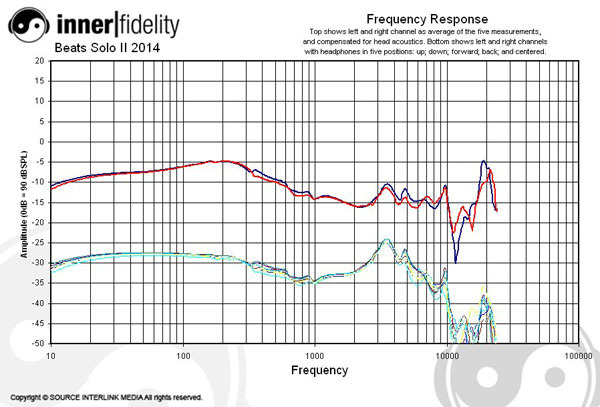
Here the emphasis on low frequencies is weaker, and the mids are much better developed. And it makes no sense to guess which journalists are right - most likely, both editions were faced with interference and inaccurate measurements. We go further. Headphones Beats Solo 2 Wireless in the clutches of the editors Rtings:

Excellent schedule with bass that do not clog the rest of the spectrum, but at the same time collected and powerful, without differences. Very good middle and only at high frequencies there is a certain decline. How so? After all, Solo 2 and Solo 2 Wireless are models of the same series, which differ mainly in the Bluetooth module. All the same errors in measurements! By the way, in my opinion and opinion of the sound producer Dmitry Ostrovsky already known to you (audiofun.ostro@gmail.com), it is the Rtings schedule that best reflects the real sound handwriting of all the second-generation Beats Solo. Well, seriously, let's drop the prejudices: the Beats have long learned how to make good headphones. Another question is that they will always be worth ten times more expensive than competitors, well, so this is a market model. Those who lack the Beats and don’t need ponts can always buy the hero of my latest reviews - “BlutIo” (read with emphasis on I).
So let's see the Bluedio graphics! Measurements are made by the manufacturer in a professional studio and at the stands. Subjectively, during the audio tests, Dmitry Ostrovsky and I did not hear any significant deviations from the stated frequency response curves.

The smooth graph shows that there are no serious differences in sound. Bass is not enough, ultra-low frequencies are generally cut off. But the middle and the top reproduced great. Even the ultra-high frequencies on the graph look very decent - if you are over 40 years old, most likely, the detail of playing Bluedio Air headphones is even redundant.

The legendary headphones Bluedio R + Legend, alas, is already completely sold out. However, to return to them again does not hurt. Here is what I wrote earlier, quoting the sound producer Dmitry Ostrovsky:
“This model has very deep and well-developed bass, the whole range of low frequencies sounds very good. The mids are a bit failed, they have no accent, lower detail. But there are good high frequencies, worked out and detailed. ”
What do we see on the chart? Exactly this. It can also be noted that ultra-high headphones are also slaughtered. Somewhere from 18 kHz sounds will be almost unheard of.

Bluedio Vinyl Premium headphones are a bit more expensive (and they look - MUCH more expensive). The blog online retailer UMmall is devoted to them a separate review . What about sound quality? And with the sound quality everything is great! Seriously: amazingly smooth schedule with a slight rise on the upper bass and lower middle. Good middle, excellent highs with a small dip at 15 kHz. This is a very good schedule. And I also heard these headphones live and I can confirm: everything is just as good as it is written here. Headphones sound just super! And doubly supersky, if you remember the price tag - one would easily expect that “ears” of such a level as materials and assembly, as well as with such a good sound, would be worth 10-12 thousand. But Bluedio has a Vinyl Premium model for only 4,300 rubles.

I am often reproached for why I compare Bluedio headphones with the Beats, and not with another Chinese company? Allegedly, Beats engineers do not matter, marketing positioning is important, and the like should be compared with the like. Regarding the former Beats engineers who “settled down” at Bluedio after buying Beats by Apple, I already wrote a heartfelt speech, I can only duplicate the link . And about similar with similar: here again two graphs, this time nearby. Beats Solo 2 Wireless for 17,000 rubles and Bluedio Vinyl Premium for 4,300 rubles.
Beats Solo 2 Wireless with a partially failed middle and a failed high.
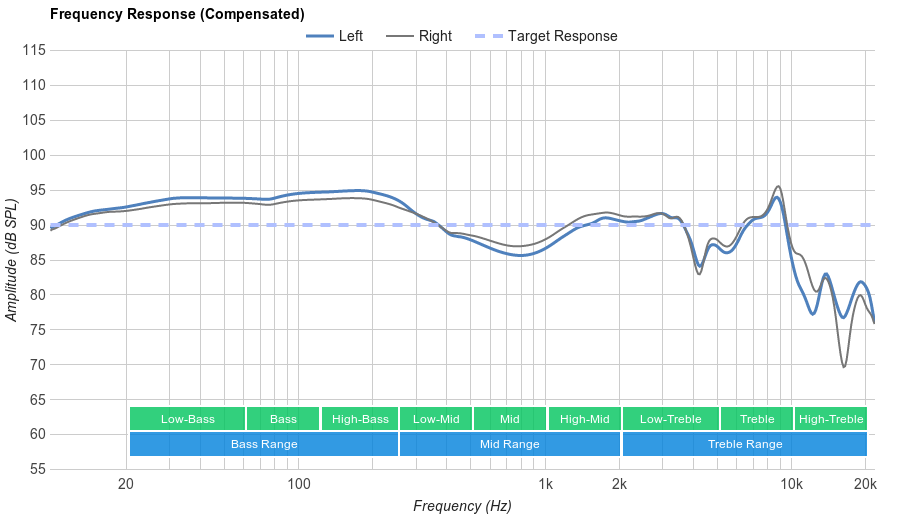
Bluedio Vinyl Premium with a noticeably more harmonious and balanced sound.

You can talk a lot about measurement errors, but the fact remains. If you focus on the frequency response graphics, headphones Bluedio and Beats deserve to be discussed in the same material.
Want to see a really bad frequency response graph? Apple EarPods in the studio!

There is no bass. Absolutely not! Something similar to the sound appears only in the upper bass area. Tops also failed, only symptomatic peaks represent something like a sound. What is the reason why Apple EarPods are considered by many to be excellent headphones, such that “you don’t need more”? Exclusively due to the developed middle (many people like vocals in music, and perceive everything else as background) and the Apple nameplate. Without the Apple nameplate, no one would have looked at these butts, but would have taken something cheaper and well made. If only VE Monk Plus, for example.
Philips, whose headphones also participated in our big sound test, also takes an example from Apple and Beats and does not publish its frequency response graphs. In the archives of the resource, I found a graph of a rather expensive Philips SHP9500 model, which was taken out of production several years ago, but was once sold for about $ 150.
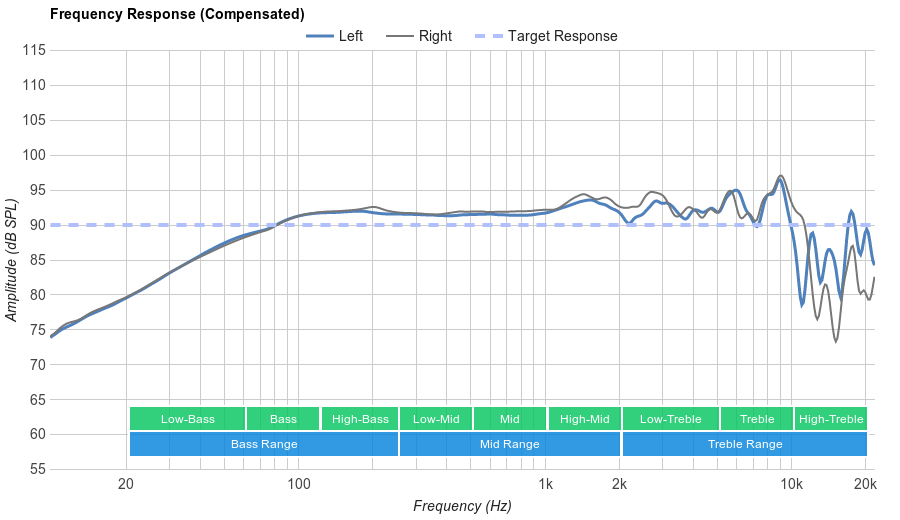
It’s stupid to compare, but the graphics really look like Apple EarPods: the same lack of bass and even more problematic high frequencies. But the middle is cool, here the company has worked. However, in general, such headphones should cost thousands of 3-4, and not 6-10, for which these Phillips sold in 2014.
If you sometimes go to audioforums, then you probably noticed members there who were not yet banned in Russia (but very close to that) sect of Koss Porta Pro witnesses, holy and unconditionally believing that "there was no headphone, no, and there will not be." Please, here is a diagram of these “their divine is better and never will be”:

Ultra-low frequencies do not exist, they are compensated by the abundance of the upper bass. Average fails, normal vocals are not here and never will be. Instead of high frequencies - a disaster. And this is for 3 500 rubles! Transferring “to our money” is like taking Bluedio T2 + (cost in the UMmall store is 2,000 rubles), cut off the player and the radio from it, remove Bluetooth, degrade the middle and double the price tag to 3,500 rubles. However, even for such a product is a merchant, the Koss Porta Pro model in this modification has been sold for more than ten years.
But the excellent wireless headphones Sennheiser Momentum 2.0 for 14 000 rubles (wireless Sennheiser Momentum were also in our audio test) demonstrate how to make headphones.

An even balanced sound throughout the spectrum, except for high frequencies, where the dips clearly go beyond the boundaries of reasonable “compensatory” distortion. It would be interesting to listen to them in comparison with Bluedio Vinyl Premium, which at the time of our audio test were not yet sold in Russia from the only official representative of Bladio, the Internet retailer UMmall . In my opinion, both models have extremely decent and, in general, comparable frequency response graphs. Here, look again at Bluedio Vinyl Premium:

1) The frequency response graph is not an absolute and universal means of determining the quality of sound. Too many measurement errors.
2) Even headphones with a perfect frequency response graph do not necessarily fit you personally due to the specific structure of your ears and / or musical tastes.
3) Brands are reluctant to share the frequency response of their headphones, Bluedio - one of the few honest manufacturers, which reveals all the cards to the buyer.
4) The frequency response graphs of Bluedio headphones are comparable to those of more expensive headphones and effortlessly “make” inexpensive “ears” of famous brands.
5) You will buy Bluedio, I recommend the flagship model Vinyl Premium and only from the official representative of “Bladio” in Russia - the Internet retailer UMmall.ru . Fortunately, headphones are sold at UMmall at fair “Chinese” prices - price tags on all Ali Express products are the same as on UMmall.
Good music to you, friends!

Let's start with the materiel
Let's first recall very quickly what this graph shows. The frequency response graph shows the level of sound pressure (loudness) over the entire frequency spectrum. It usually looks something like this:
')

At first glance, this is strange: what kind of curves, if we want all the frequencies to play the same? Come on straight line! But here biology interferes, namely the structure of our ear canal. The sounds in the ear are distorted, and so that we perceive music harmoniously, some frequencies must be played louder, some are quieter. Again, the headphone form factor has an effect: if they fit to the ear from the outside, some frequencies are heard better than others. If they are inserted into the ear canal, other frequencies come to the fore. To compensate for this, audio engineers have to twist the sound of the headphones, bending this very frequency response line. Therefore, a small failure in the frequency response at high frequencies is considered completely normal - this compensates for the features of the sound in the human ear.
Another nuance is that we all have different ears. And we hear the sounds in different ways. So the same headphones in the ears of two different people may sound oh-so-very different. So buy headphones for frequency response without first listening, I strongly advise you not to.
Personal preferences of users also play a role: not everyone needs “accurate” music playback. Someone likes to have more bass, and someone, on the contrary, can not tolerate low frequencies. Here the manufacturer and adapts as it can, experimenting with the frequency response.
And if you still have few nuances, here's another one: the older we get, the worse we hear the upper frequency spectrum. And if the child perfectly hears the range of 20 Hz - 20 kHz, then the adult does not hear anything above 17 kHz, unless he has specially trained his ear. So on the graph, ultra-high frequencies can not be given much attention.
In general, the rule for reading such graphs is one: good headphones differ from bad ones by the absence of sharp drops in the graph. If the lines are smooth, without narrow peaks and dips, the sound will be harmonious and pleasant. You will not necessarily like it personally (tastes!), But, in any case, headphones with a smooth frequency response graph are of high quality.
Subtleties of measurement
It seems that everything is very simple: look at the chart and determine. Here the basses are turned up, here the middle is failed, and here in general the devil knows what. But no matter how. The main question is who made the graphics, on what equipment and how it measured.

In an amicable way, the frequency response needs to be measured with a super-sensitive microphone set in an exact imitation of the human ear. This is what all the headphone manufacturers do (and some, like Bluedio, even have the courage to publish these graphics). More information about the stands and the inevitable errors even in laboratory conditions can be found here, at "Giktayms", in the material that breaks the covers . But something else is important for us: most manufacturers do not post AFC graphics at all. Whether they have nothing to be proud of, or arrogant vendors believe that such graphics are not for average minds - in any case, we were left without important characteristics. And all that remains for us is the frequency response graphs from the reviews of journalists. And there the spread is even stronger, because not every edition can provide good studio conditions for measurements.
Not to be unfounded, let's take a specific model of headphones and see the graphics. The Beats Solo 2 headphones, already familiar to you, received the following frequency response graph from the resource Ferra.ru, which is very respected by me.

As you can see, the journalists turned out to have the typical “bass” headphones with overblown low frequencies, failed mid and high frequencies. This "bubnezhka", which already here is 15-20 thousand rubles! But wait! The same headphones from the resource Inner Fidelity received the following schedule:

Here the emphasis on low frequencies is weaker, and the mids are much better developed. And it makes no sense to guess which journalists are right - most likely, both editions were faced with interference and inaccurate measurements. We go further. Headphones Beats Solo 2 Wireless in the clutches of the editors Rtings:

Excellent schedule with bass that do not clog the rest of the spectrum, but at the same time collected and powerful, without differences. Very good middle and only at high frequencies there is a certain decline. How so? After all, Solo 2 and Solo 2 Wireless are models of the same series, which differ mainly in the Bluetooth module. All the same errors in measurements! By the way, in my opinion and opinion of the sound producer Dmitry Ostrovsky already known to you (audiofun.ostro@gmail.com), it is the Rtings schedule that best reflects the real sound handwriting of all the second-generation Beats Solo. Well, seriously, let's drop the prejudices: the Beats have long learned how to make good headphones. Another question is that they will always be worth ten times more expensive than competitors, well, so this is a market model. Those who lack the Beats and don’t need ponts can always buy the hero of my latest reviews - “BlutIo” (read with emphasis on I).
So let's see the Bluedio graphics! Measurements are made by the manufacturer in a professional studio and at the stands. Subjectively, during the audio tests, Dmitry Ostrovsky and I did not hear any significant deviations from the stated frequency response curves.
Bluedio A (Air) (3 000 rubles)

The smooth graph shows that there are no serious differences in sound. Bass is not enough, ultra-low frequencies are generally cut off. But the middle and the top reproduced great. Even the ultra-high frequencies on the graph look very decent - if you are over 40 years old, most likely, the detail of playing Bluedio Air headphones is even redundant.
Bluedio R + (currently out of stock)

The legendary headphones Bluedio R + Legend, alas, is already completely sold out. However, to return to them again does not hurt. Here is what I wrote earlier, quoting the sound producer Dmitry Ostrovsky:
“This model has very deep and well-developed bass, the whole range of low frequencies sounds very good. The mids are a bit failed, they have no accent, lower detail. But there are good high frequencies, worked out and detailed. ”
What do we see on the chart? Exactly this. It can also be noted that ultra-high headphones are also slaughtered. Somewhere from 18 kHz sounds will be almost unheard of.
Bluedio Vinyl Premium (4 300 rubles). Bluedio flagship headphones with a classic vintage design and original floating cups

Bluedio Vinyl Premium headphones are a bit more expensive (and they look - MUCH more expensive). The blog online retailer UMmall is devoted to them a separate review . What about sound quality? And with the sound quality everything is great! Seriously: amazingly smooth schedule with a slight rise on the upper bass and lower middle. Good middle, excellent highs with a small dip at 15 kHz. This is a very good schedule. And I also heard these headphones live and I can confirm: everything is just as good as it is written here. Headphones sound just super! And doubly supersky, if you remember the price tag - one would easily expect that “ears” of such a level as materials and assembly, as well as with such a good sound, would be worth 10-12 thousand. But Bluedio has a Vinyl Premium model for only 4,300 rubles.

"B" vs "B"
I am often reproached for why I compare Bluedio headphones with the Beats, and not with another Chinese company? Allegedly, Beats engineers do not matter, marketing positioning is important, and the like should be compared with the like. Regarding the former Beats engineers who “settled down” at Bluedio after buying Beats by Apple, I already wrote a heartfelt speech, I can only duplicate the link . And about similar with similar: here again two graphs, this time nearby. Beats Solo 2 Wireless for 17,000 rubles and Bluedio Vinyl Premium for 4,300 rubles.
Beats Solo 2 Wireless with a partially failed middle and a failed high.

Bluedio Vinyl Premium with a noticeably more harmonious and balanced sound.

You can talk a lot about measurement errors, but the fact remains. If you focus on the frequency response graphics, headphones Bluedio and Beats deserve to be discussed in the same material.
What about the others?
Want to see a really bad frequency response graph? Apple EarPods in the studio!

There is no bass. Absolutely not! Something similar to the sound appears only in the upper bass area. Tops also failed, only symptomatic peaks represent something like a sound. What is the reason why Apple EarPods are considered by many to be excellent headphones, such that “you don’t need more”? Exclusively due to the developed middle (many people like vocals in music, and perceive everything else as background) and the Apple nameplate. Without the Apple nameplate, no one would have looked at these butts, but would have taken something cheaper and well made. If only VE Monk Plus, for example.
Philips, whose headphones also participated in our big sound test, also takes an example from Apple and Beats and does not publish its frequency response graphs. In the archives of the resource, I found a graph of a rather expensive Philips SHP9500 model, which was taken out of production several years ago, but was once sold for about $ 150.

It’s stupid to compare, but the graphics really look like Apple EarPods: the same lack of bass and even more problematic high frequencies. But the middle is cool, here the company has worked. However, in general, such headphones should cost thousands of 3-4, and not 6-10, for which these Phillips sold in 2014.
If you sometimes go to audioforums, then you probably noticed members there who were not yet banned in Russia (but very close to that) sect of Koss Porta Pro witnesses, holy and unconditionally believing that "there was no headphone, no, and there will not be." Please, here is a diagram of these “their divine is better and never will be”:

Ultra-low frequencies do not exist, they are compensated by the abundance of the upper bass. Average fails, normal vocals are not here and never will be. Instead of high frequencies - a disaster. And this is for 3 500 rubles! Transferring “to our money” is like taking Bluedio T2 + (cost in the UMmall store is 2,000 rubles), cut off the player and the radio from it, remove Bluetooth, degrade the middle and double the price tag to 3,500 rubles. However, even for such a product is a merchant, the Koss Porta Pro model in this modification has been sold for more than ten years.
But the excellent wireless headphones Sennheiser Momentum 2.0 for 14 000 rubles (wireless Sennheiser Momentum were also in our audio test) demonstrate how to make headphones.

An even balanced sound throughout the spectrum, except for high frequencies, where the dips clearly go beyond the boundaries of reasonable “compensatory” distortion. It would be interesting to listen to them in comparison with Bluedio Vinyl Premium, which at the time of our audio test were not yet sold in Russia from the only official representative of Bladio, the Internet retailer UMmall . In my opinion, both models have extremely decent and, in general, comparable frequency response graphs. Here, look again at Bluedio Vinyl Premium:

Let's summarize
1) The frequency response graph is not an absolute and universal means of determining the quality of sound. Too many measurement errors.
2) Even headphones with a perfect frequency response graph do not necessarily fit you personally due to the specific structure of your ears and / or musical tastes.
3) Brands are reluctant to share the frequency response of their headphones, Bluedio - one of the few honest manufacturers, which reveals all the cards to the buyer.
4) The frequency response graphs of Bluedio headphones are comparable to those of more expensive headphones and effortlessly “make” inexpensive “ears” of famous brands.
5) You will buy Bluedio, I recommend the flagship model Vinyl Premium and only from the official representative of “Bladio” in Russia - the Internet retailer UMmall.ru . Fortunately, headphones are sold at UMmall at fair “Chinese” prices - price tags on all Ali Express products are the same as on UMmall.
Good music to you, friends!
Source: https://habr.com/ru/post/402919/
All Articles